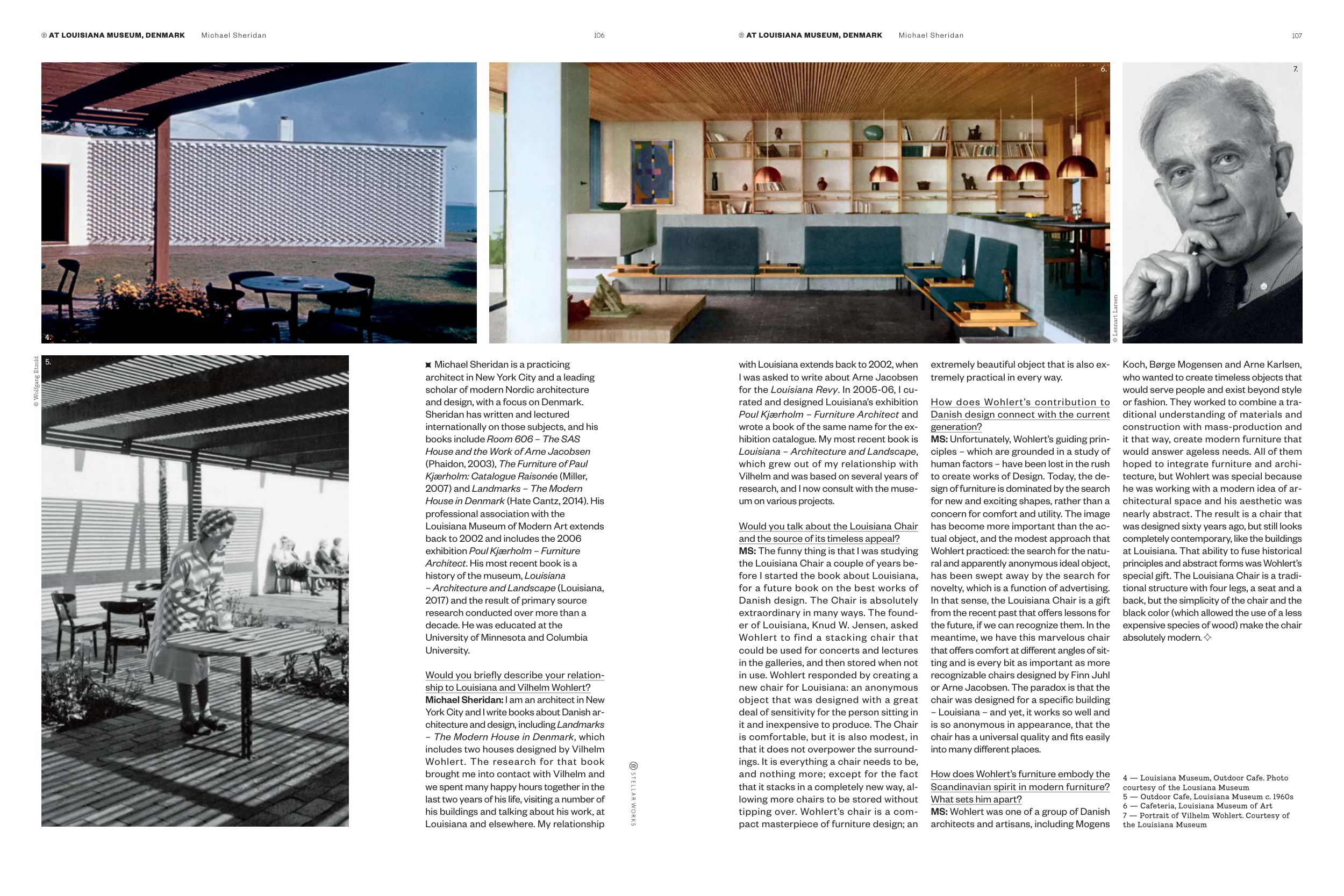106
107
Michael Sheridan
Michael Sheridan
AT LOUISIANA MUSEUM, DENMARK
AT LOUISIANA MUSEUM, DENMARK
Michael Sheridan is a practicing
architect in New York City and a leading
scholar of modern Nordic architecture
and design, with a focus on Denmark.
Sheridan has written and lectured
internationally on those subjects, and his
books include Room 606 – The SAS
House and the Work of Arne Jacobsen
(Phaidon, 2003), The Furniture of Paul
Kjærholm: Catalogue Raisonée (Miller,
2007) and Landmarks – The Modern
House in Denmark (Hate Cantz, 2014). His
professional association with the
Louisiana Museum of Modern Art extends
back to 2002 and includes the 2006
exhibition Poul Kjærholm – Furniture
Architect. His most recent book is a
history of the museum, Louisiana
– Architecture and Landscape (Louisiana,
2017) and the result of primary source
research conducted over more than a
decade. He was educated at the
University of Minnesota and Columbia
University.
Would you briefly describe your relation-
ship to Louisiana and Vilhelm Wohlert?
Michael Sheridan: I am an architect in New
York City and I write books about Danish ar-
chitecture and design, including Landmarks
– The Modern House in Denmark, which
includes two houses designed by Vilhelm
Wohlert. The research for that book
brought me into contact with Vilhelm and
we spent many happy hours together in the
last two years of his life, visiting a number of
his buildings and talking about his work, at
Louisiana and elsewhere. My relationship
4 — Louisiana Museum, Outdoor Cafe. Photo
courtesy of the Lousiana Museum
5 — Outdoor Cafe, Louisiana Museum c. 1960s
6 — Cafeteria, Louisiana Museum of Art
7 — Portrait of Vilhelm Wohlert. Courtesy of
the Louisiana Museum
with Louisiana extends back to 2002, when
I was asked to write about Arne Jacobsen
for the Louisiana Revy. In 2005-06, I cu-
rated and designed Louisiana’s exhibition
Poul Kjærholm – Furniture Architect and
wrote a book of the same name for the ex-
hibition catalogue. My most recent book is
Louisiana – Architecture and Landscape,
which grew out of my relationship with
Vilhelm and was based on several years of
research, and I now consult with the muse-
um on various projects.
Would you talk about the Louisiana Chair
and the source of its timeless appeal?
MS: The funny thing is that I was studying
the Louisiana Chair a couple of years be-
fore I started the book about Louisiana,
for a future book on the best works of
Danish design. The Chair is absolutely
extraordinary in many ways. The found-
er of Louisiana, Knud W. Jensen, asked
Wohlert to find a stacking chair that
could be used for concerts and lectures
in the galleries, and then stored when not
in use. Wohlert responded by creating a
new chair for Louisiana: an anonymous
object that was designed with a great
deal of sensitivity for the person sitting in
it and inexpensive to produce. The Chair
is comfortable, but it is also modest, in
that it does not overpower the surround-
ings. It is everything a chair needs to be,
and nothing more; except for the fact
that it stacks in a completely new way, al-
lowing more chairs to be stored without
tipping over. Wohlert’s chair is a com-
pact masterpiece of furniture design; an
extremely beautiful object that is also ex-
tremely practical in every way.
How does Wohlert’s contribution to
Danish design connect with the current
generation?
MS: Unfortunately, Wohlert’s guiding prin-
ciples – which are grounded in a study of
human factors – have been lost in the rush
to create works of Design. Today, the de-
sign of furniture is dominated by the search
for new and exciting shapes, rather than a
concern for comfort and utility. The image
has become more important than the ac-
tual object, and the modest approach that
Wohlert practiced: the search for the natu-
ral and apparently anonymous ideal object,
has been swept away by the search for
novelty, which is a function of advertising.
In that sense, the Louisiana Chair is a gift
from the recent past that offers lessons for
the future, if we can recognize them. In the
meantime, we have this marvelous chair
that offers comfort at different angles of sit-
ting and is every bit as important as more
recognizable chairs designed by Finn Juhl
or Arne Jacobsen. The paradox is that the
chair was designed for a specific building
– Louisiana – and yet, it works so well and
is so anonymous in appearance, that the
chair has a universal quality and fits easily
into many different places.
How does Wohlert’s furniture embody the
Scandinavian spirit in modern furniture?
What sets him apart?
MS: Wohlert was one of a group of Danish
architects and artisans, including Mogens
Koch, Børge Mogensen and Arne Karlsen,
who wanted to create timeless objects that
would serve people and exist beyond style
or fashion. They worked to combine a tra-
ditional understanding of materials and
construction with mass-production and
it that way, create modern furniture that
would answer ageless needs. All of them
hoped to integrate furniture and archi-
tecture, but Wohlert was special because
he was working with a modern idea of ar-
chitectural space and his aesthetic was
nearly abstract. The result is a chair that
was designed sixty years ago, but still looks
completely contemporary, like the buildings
at Louisiana. That ability to fuse historical
principles and abstract forms was Wohlert’s
special gift. The Louisiana Chair is a tradi-
tional structure with four legs, a seat and a
back, but the simplicity of the chair and the
black color (which allowed the use of a less
expensive species of wood) make the chair
absolutely modern.
4.
5.
6.
7.
© Wolfgang Etzold
© Lennart Larsen


